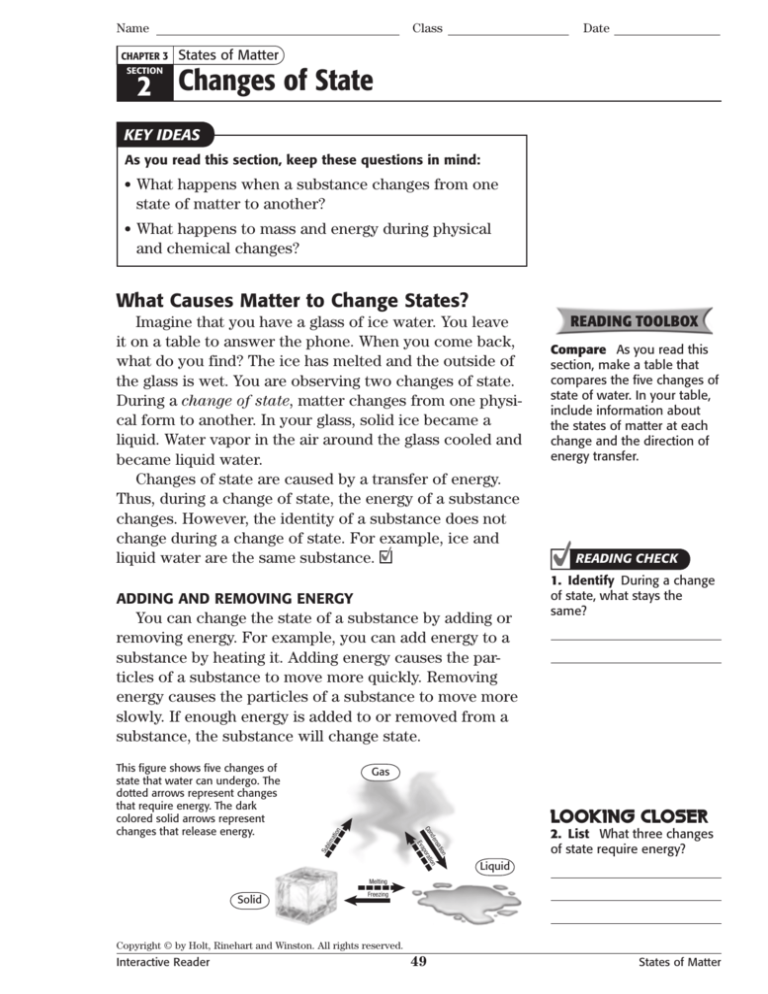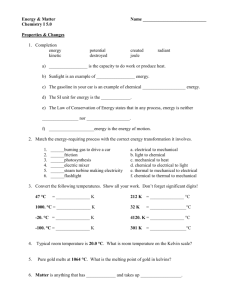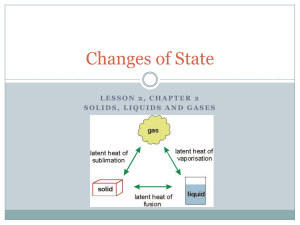
Name
CHAPTER 3
Class
Date
States of Matter
SECTION
2 Changes of State
KEY IDEAS
As you read this section, keep these questions in mind:
• What happens when a substance changes from one
state of matter to another?
• What happens to mass and energy during physical
and chemical changes?
What Causes Matter to Change States?
Imagine that you have a glass of ice water. You leave
it on a table to answer the phone. When you come back,
what do you find? The ice has melted and the outside of
the glass is wet. You are observing two changes of state.
During a change of state, matter changes from one physical form to another. In your glass, solid ice became a
liquid. Water vapor in the air around the glass cooled and
became liquid water.
Changes of state are caused by a transfer of energy.
Thus, during a change of state, the energy of a substance
changes. However, the identity of a substance does not
change during a change of state. For example, ice and
liquid water are the same substance.
ADDING AND REMOVING ENERGY
You can change the state of a substance by adding or
removing energy. For example, you can add energy to a
substance by heating it. Adding energy causes the particles of a substance to move more quickly. Removing
energy causes the particles of a substance to move more
slowly. If enough energy is added to or removed from a
substance, the substance will change state.
Compare As you read this
section, make a table that
compares the five changes of
state of water. In your table,
include information about
the states of matter at each
change and the direction of
energy transfer.
READING CHECK
1. Identify During a change
of state, what stays the
same?
Gas
EHHDBG@<EHL>K
2. List What three changes
of state require energy?
Su
blim
n
n
atio
p or
io
sat
E va
en
nd
atio
n
Co
This figure shows five changes of
state that water can undergo. The
dotted arrows represent changes
that require energy. The dark
colored solid arrows represent
changes that release energy.
READING TOOLBOX
Liquid
Melting
Solid
Freezing
Copyright © by Holt, Rinehart and Winston. All rights reserved.
Interactive Reader
49
States of Matter
Name
SECTION 2
Class
Date
Changes of State continued
TEMPERATURE AND ENERGY
READING CHECK
3. Explain Why may the
temperature of a substance
change when energy is
added?
In most cases, when you add energy to a substance,
the particles in the substance move more quickly. In
other words, adding energy can increase the kinetic
energy of the particles. Recall that temperature is a
measure of the average kinetic energy of particles in a
substance.
When you remove energy from a substance, the
particles in the substance usually move more slowly.
Removing energy can decrease the kinetic energy of the
particles. Thus, as you remove energy from a substance,
its temperature usually decreases.
CHANGES OF STATE THAT REQUIRE ENERGY
READING CHECK
4. Define What is melting?
8g^i^XVaI]^c`^c\
Some changes of state can happen only if energy is
added. Melting is the change in state from a solid to a
liquid. When you heat a solid, you transfer energy to the
substance’s particles. As the particles gain energy, they
vibrate faster. When the particles have enough energy to
break from their rigid positions, the substance melts. The
melting point is the temperature at which a substance
changes from a solid to a liquid. The melting point of a
substance can change if pressure changes.
Evaporation is the change in state from a liquid to a
gas. Boiling is evaporation that happens throughout a liquid at a specific temperature and pressure. The temperature at which a liquid boils is its boiling point.
Sublimation is the change in state from a solid to
a gas. For example, solid carbon dioxide, or dry ice,
changes to a gas at room temperature.
5. Compare How does
melting differ from
sublimation?
Some solids can change to a gas
without first changing to a liquid.
This is called sublimation.
Copyright © by Holt, Rinehart and Winston. All rights reserved.
Interactive Reader
50
States of Matter
Name
SECTION 2
Class
Date
Changes of State continued
CHANGES OF STATE THAT RELEASE ENERGY
Some changes of state release energy. For example,
when water vapor in the air becomes a liquid, energy is
released. This process is an example of condensation.
Condensation is the change in state from a gas to a liquid. The condensation point is the temperature at which
a gas becomes a liquid. Condensation often happens
when a gas touches a cool surface. For instance, drops of
water may form on a glass of ice water as air touches the
cool glass.
Water vapor can change
to drops of water when it
touches a cool surface, such
as grass or dragonfly wings.
EHHDBG@<EHL>K
6. Identify What change of
state does this figure show?
FREEZING POINT
Freezing is the change in state from a liquid to a solid.
The temperature at which a substance freezes is its
freezing point. The freezing point of a substance is the
same as its melting point. Recall that energy must be
added for a substance to melt. When a substance freezes,
energy is released.
What Happens to Temperature During
Changes of State?
When a substance loses or gains energy, either its temperature changes or its state changes. In other words,
these two changes do not happen at the same time. The
temperature of a substance does not change during a
change of state.
For example, if you heat a pot of water on a stove, the
temperature of the water increases. When the water’s
temperature reaches the boiling point, adding more
energy will not increase the temperature further. Instead,
adding energy causes the water to change state. The temperature of the water will stay the same until all of the
water has changed to water vapor.
READING CHECK
7. Describe What happens
to the temperature of a
substance during a change
of state?
Copyright © by Holt, Rinehart and Winston. All rights reserved.
Interactive Reader
51
States of Matter
Name
SECTION 2
Class
Date
Changes of State continued
Graphing Skills
$IBOHFTPG4UBUFGPS8BUFS
8. Label On the graph,
label each of the four arrows
with one of the following:
melting, freezing, boiling,
condensing.
&OFSHZL+
9. Identify What is the
melting point of water? What
is the boiling point?
&OFSHZSFNPWFE
&OFSHZBEEFE
1
2
10. Identify Put boxes
around the parts of the graph
where energy is being added
but the state is not changing.
o
5FNQFSBUVSF$
1 When water freezes, energy is released, or removed. When ice melts, energy is
absorbed, or added.
2 When water vapor condenses, energy is released. When liquid water becomes a
gas, or vaporizes, energy is absorbed.
Solid ice
8g^i^XVaI]^c`^c\
11. Describe In a chemical
change, how does the mass
of the reactants compare to
the mass of the products?
Liquid water
Water vapor
What Happens to Mass During Physical and
Chemical Changes?
Imagine weighing an ice cube. After the ice cube
melts, you weigh the liquid that formed. Which state
weighed more—the solid or the liquid? Neither—they
have the same mass. During a chemical or physical
change, mass cannot be created or destroyed. This is the
law of conservation of mass. Conserve means “to keep
the same.” When the ice melts and becomes liquid water,
no mass is lost.
Law of Conservation of Mass:
Mass cannot be created or destroyed.
Copyright © by Holt, Rinehart and Winston. All rights reserved.
Interactive Reader
52
States of Matter
Name
SECTION 2
Class
Date
Changes of State continued
What Happens to Energy During Chemical
and Physical Changes?
Just like mass, energy cannot be created or destroyed
during a physical or chemical change. This is known
as the law of conservation of energy. Energy can be
changed to another form of energy. However, the total
amount of energy before the change must equal the total
amount of energy after the change.
Law of Conservation of Energy:
Energy cannot be created or destroyed.
For example, when a lawn mower burns gasoline for
energy, a chemical change takes place. The lawn mower
uses some of the energy stored in the gasoline. Some
of the energy is transferred to the environment as heat.
Thus, the total amount of energy released equals the
energy used by the lawn mower, plus heat energy. No
energy is created or destroyed.
8g^i^XVa I]^c`^c\
12. Infer In a chemical
change, how does the total
energy of the reactants
compare to the total energy
of the products?
When a lawn mower burns gasoline, the
forms of energy change. However, the total
amount of energy stays the same.
Copyright © by Holt, Rinehart and Winston. All rights reserved.
Interactive Reader
53
States of Matter
Name
Class
Date
Section 2 Review
SECTION VOCABULARY
condensation the change of state from a gas to
a liquid
evaporation the change of state from a liquid to
a gas
sublimation the process in which a solid changes directly into a gas (the term is sometimes
also used for the reverse process)
1. Define What is a change of state?
2. Identify What causes a change of state?
3. Describe Relationships What two things can happen to a substance when energy
is added?
4. Describe Identify and describe two changes of state that release energy.
5. Compare Identify two ways condensation differs from boiling. Identify one way
they are similar.
6. State In your own words, what is the law of conservation of mass?
7. Describe What would happen to the temperature of boiling water if you added
energy?
Copyright © by Holt, Rinehart and Winston. All rights reserved.
Interactive Reader
54
States of Matter









